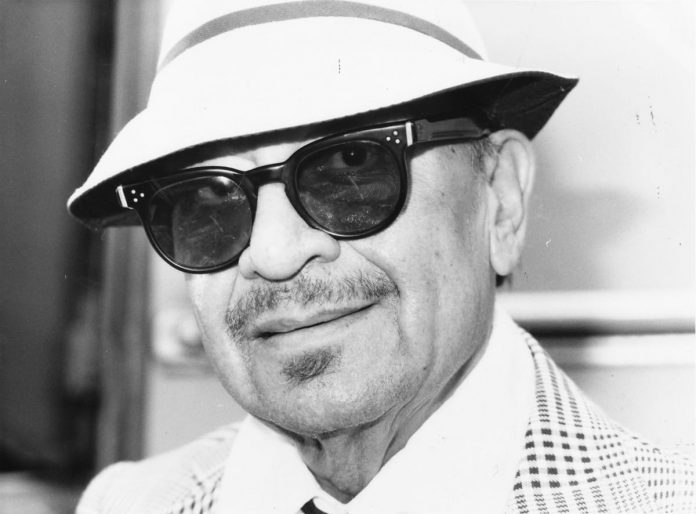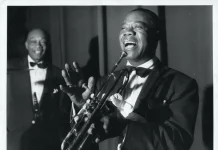As a child Barney Bigard had at first resisted his family’s attempts to point him to a career in music, choosing on his own to become an engraver. But he capitulated to take clarinet lessons from Lorenzo Tio Jr., one of the classic teachers and exponents of the instrument.
Tio eventually inspired him to take up the life in music but because accomplished clarinettists abounded in the city, Barney decided to specialise on the tenor saxophone, and this is where we first heard him in recordings alongside Louis Armstrong and as a member of the King Oliver band. In the Oliver band he sat alongside two clarinet players who at that time had more renown than he did – Albert Nicholas and Darnell Howard. When Howard left the band, Oliver persuaded Barney to give clarinet priority over the tenor.
Like Barney, his predecessor in the Ellington band, Rudy Jackson, was a native of New Orleans. Like Barney, he’d been in King Oliver’s band before he joined Duke. Another “home boy”, bassist Wellman Braud, approached Barney one night and asked if he’d be interested in joining the embryo Ellington band. “Duke wants to get a clarinet player to take the place of Rudy Jackson. He’s had enough of Rudy Jackson.”
No wonder. When Rudy joined Duke he brought with him a song that he claimed to have written called Creole Love Call. Impressed, Duke recorded it. When the record appeared it emerged that Rudy had stolen the tune, previously known as Camp Meeting Blues, from King Oliver, who proceeded to sue both Duke and his clarinettist.
Braud came again to the Nest, where Barney was playing in New York. “Duke wants you to go over to his apartment to talk.” Barney did and they talked for over an hour. Barney was happy that Duke talked democratically of “we” and “our band” and, even though it meant a drop in pay, Barney agreed to join. He did so on 1 January 1928 and we can tell how accomplished he was because eight days later he made his first recordings with the band, providing a chalumeau solo reminiscent of Jimmie Noone on Stack O’ Lee Blues and some broiling tenor on Bugle Call Rag. Bigard quickly eased in alongside fellow new star Bubber Miley and veteran Tricky Sam Nanton to become one of the band’s strongest individual voices. Johnny Hodges joined soon after, and Duke had the most gifted and adaptable solo team in jazz, a qualification he held without challenge for many years.
By 1929 Bigard had established himself as the most gifted clarinet player in jazz, in the process making Jimmie Noone, who had been his early inspiration, seem wooden in his solos. Bigard was by now a virtuoso, thriving in what must have been one of the most potent meetings of minds amongst the many that Duke Ellington engendered. Barney’s dazzling ability to race with full tone through the registers of the instrument was never matched.
It’s interesting to listen to the arrangements that Goodman and Shaw had crafted to pit their sounds against that of their ensembles, but Bigard, without artifice, was able to create that role without a score. He also provided Duke with an invaluable tool for creating accents or emphases, as well as the knowledge that Barney, with that glorious sound, could be let loose to roam across and counterpoint the rest of the band in an almost operatic display of high drama. Bigard and Hodges exultantly became the most expressive reedmen in jazz, with only Hawkins approaching their eloquence and tonal perfection.
All Barney”s solos with Duke make wonderful listening, but to have your breath taken away, don’t miss Saturday Night Function (16 January 1928) which, apart from Barney skimming his blues through the registers has the newly rampant team of Nanton, Hodges and Freddy Jenkins letting fly. That track appears on ASV AJA 5507. The album’s called Barney’s Bounce, and its 24 tracks hold all manner of delights, climaxed by some of Barney’s small-group tracks. But those drawn from his 1939 Jazzopators, with Rex, Tizol and Carney, tragically omit the dazzling Stompy Jones, which seems now to be lost to us forever. Harlem Airshaft, Across The Track Blues and three more small-group tracks with Duke come from 1940.
But Barney permeates any of the 1940 output in his final pirouetting with Duke, and you should have or listen to the whole year’s output. And those wonderful tracks by the team of Rex, Barney and Django, represented only by I Know That You Know, are vital. The 1936 Clarinet Lament was another to decimate the opposition, with great composition by Duke. Sadly the ultimate track is C Jam Blues, with Louis and Tea from 1947, showing how quickly Barney went to seed after he left Duke.
Don’t miss the wondrous Black Beauty with the orchestra from March 1928 on ASV AJA 5573 wherein you’ll also find a multitude of the best from the 20s.
See part one of this article
See part three of this article
















